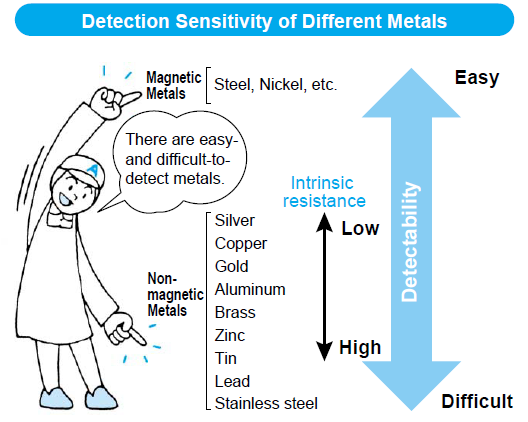Metal detector FAQ
1. What is the metal detector/needle detector sensitivity?
The measure of a metal detector’s ability to detect a specific type and size of metal contaminant. The better the sensitivity of the metal detector, the smaller the pieces of irregular-shaped metal it can detect.
2. How metal detector sensitivity is measured?
Metal detector test block, in the weakness place.(center of probe) can detected min diameter, 100% detected.
3. Why the detection block it is an ball shape?
Metal detector principle it is balance coil, metal shape and direction will give effect to sensitivity.
detection block ball shape it is make sure all direction can be detected at this size.
4. What kinds of test blocks have?
Fe: Ferrous. Non-Fe: Copper. SUS: stainless steel
5. Easy and Difficult to detect metal contaminants.

(From Anritsu)
6. The metal detector passline height must match the product height.
eg: Metal detector probe/height/window/aperture size.------shoe size.
if suitable will be better preformance, can get better sensitivity.
(Industrial metal detector the smaller size the better sensitivity)
Small-product can not pass.
Large-not have good sensitivity.
7. What is the product effect?
In brief: it is the electrical conductivity of the product.
small, dry, forzen easy to detect.(have better sensitivity)
moist with salt, large mixture hard to detect.(Poor sensitivity, some may not can not use the metal detector)
8. Metal detector uses and applications
Metal detectors play an essential role in contaminant detection in a huge number of fields.
In food processing line, pharmaceutical manufacturing, cosmetics manufacturing, garment production lines.
--------------------------------------------------------
Checkweigher FAQ
1. What is a checkweigher?
Check weigher is high-precision measuring instrument designed to check the weight of individual products in motion.
Dynamic conveyor weighing machine, part of typical quality control system, ensuring that every product leaving a production
line is the right weight and corresponds to packaging requirements.
2. Checkweigher uses and applications
Checkweighers can be used in many industries as part of an effective quality assurance system. Relevant sectors include:
• Food
• Pharmaceuticals
• Cosmetics
• Beverages
• Transport/logistics
• Chemicals
• Automotive
• Metal manufacture and fabrication industries
In an increasingly competitive marketplace, checkweighers are essential in fulfilling ever-changing customer needs and in complying with local Weights & Measures standards, as well as global standards.
3. Components of a Checkweigher
There are several different checkweigher designs in common use, with components varying greatly depending on: how they are used, items being weighed, and their surrounding environment. A typical checkweighing system comprises:
• An infeed section
• A weighing section
• An outfeed section with sorting/rejecting device
• A weighing terminal as user interface
4. What is the difference between a static scale and a dynamic checkweigher?
1. Static scales measure the weight of products that stand still, whereas…
Dynamic checkweighers weigh products in motion.
2. Static scales are used for manual weighing of products or
for sample spot-checking, whereas...
Dynamic checkweighers automatically check 100 % of
the products produced
3. In order to check product weights, static scale weighing is required. This is a manual operation requiring product weighing, recording the result, and then product removal for the next weighing procedure, whereas...
Dynamic checkweighing is entirely automatic, without manual intervention or a dedicated operator: products are weighed as they pass along a production line, with off-weight products rejected from the production line by automated removal devices such as pneumatic pusher arms or air-jets (sometimes known as ‘air-blasts’).
4. Check weigher reasons, advantages and Benefits.
Avoid Costly Fines and Tarnished Brand with 100 % Weight Inspection
Protection of the Customer and Consumer
Protection of Brand and Reputation
Counting and Statistical Functions
